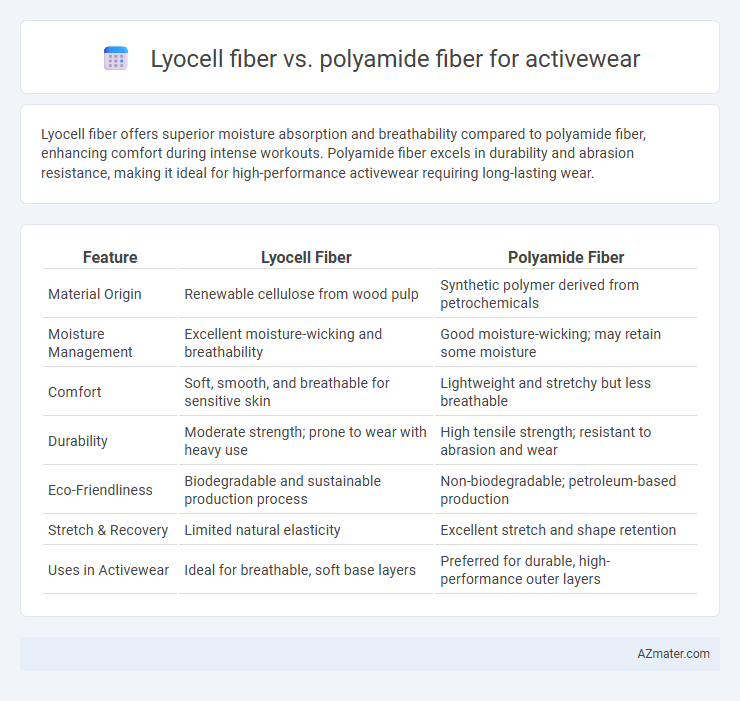Lyocell fiber offers superior moisture absorption and breathability compared to polyamide fiber, enhancing comfort during intense workouts. Polyamide fiber excels in durability and abrasion resistance, making it ideal for high-performance activewear requiring long-lasting wear.
Table of Comparison
| Feature | Lyocell Fiber | Polyamide Fiber |
|---|---|---|
| Material Origin | Renewable cellulose from wood pulp | Synthetic polymer derived from petrochemicals |
| Moisture Management | Excellent moisture-wicking and breathability | Good moisture-wicking; may retain some moisture |
| Comfort | Soft, smooth, and breathable for sensitive skin | Lightweight and stretchy but less breathable |
| Durability | Moderate strength; prone to wear with heavy use | High tensile strength; resistant to abrasion and wear |
| Eco-Friendliness | Biodegradable and sustainable production process | Non-biodegradable; petroleum-based production |
| Stretch & Recovery | Limited natural elasticity | Excellent stretch and shape retention |
| Uses in Activewear | Ideal for breathable, soft base layers | Preferred for durable, high-performance outer layers |
Introduction to Lyocell and Polyamide Fibers
Lyocell fiber, derived from sustainable wood pulp through an eco-friendly closed-loop process, offers excellent moisture-wicking and breathability, making it ideal for activewear. Polyamide fiber, commonly known as nylon, is a synthetic polymer valued for its high durability, elasticity, and abrasion resistance, providing strong support and shape retention in performance garments. Both fibers contribute unique functional benefits, with Lyocell emphasizing comfort and sustainability, while Polyamide ensures robustness and long-lasting wear.
Fiber Origins and Manufacturing Processes
Lyocell fiber is derived from sustainably sourced wood pulp, primarily eucalyptus, and produced through a closed-loop solvent spinning process that recycles water and solvents to minimize environmental impact. Polyamide fiber, commonly known as nylon, originates from petrochemical polymers synthesized through energy-intensive methods involving polymerization of caprolactam or hexamethylene diamine with adipic acid. The eco-friendly production of Lyocell contrasts with the fossil fuel dependency and higher carbon footprint of polyamide, influencing sustainability considerations in activewear fabric choices.
Environmental Impact and Sustainability
Lyocell fiber, derived from sustainably sourced wood pulp through a closed-loop process, offers superior biodegradability and lower water consumption compared to polyamide, a synthetic fiber made from petroleum with significant carbon emissions and limited recyclability. Lyocell's eco-friendly production minimizes toxic chemical discharge, supporting reduced environmental pollution in activewear manufacturing. Choosing lyocell over polyamide enhances sustainability by promoting renewable resources and reducing microplastic pollution associated with synthetic fibers.
Moisture Management and Breathability
Lyocell fiber offers superior moisture management due to its high absorbency and ability to wick sweat away from the skin, keeping activewear dry and comfortable during intense workouts. Polyamide fiber, also known as nylon, excels in breathability and quick-drying properties, making it ideal for maintaining airflow and reducing overheating in activewear fabrics. Combining lyocell's natural moisture absorption with polyamide's durability and breathability results in activewear that optimizes sweat control and comfort.
Comfort and Skin Sensitivity
Lyocell fiber offers superior breathability and moisture-wicking properties, making it highly comfortable for activewear by keeping skin dry and reducing irritation. Its natural cellulose composition is hypoallergenic and gentle on sensitive skin, minimizing the risk of chafing and allergic reactions during vigorous exercise. In contrast, polyamide fiber, while durable and elastic, may trap heat and moisture, which can cause discomfort and exacerbate skin sensitivity in prolonged wear.
Durability and Strength in Activewear
Lyocell fiber exhibits high tensile strength and excellent durability, making it well-suited for activewear that demands both resilience and flexibility. Polyamide fiber, known for its superior abrasion resistance and remarkable strength-to-weight ratio, offers enhanced durability under intense physical activity and frequent washing. Both fibers provide longevity in activewear, but polyamide often outperforms Lyocell in maintaining structural integrity during high-stress workouts.
Stretch and Flexibility Comparison
Lyocell fiber offers excellent moisture-wicking properties and moderate stretch, making it breathable and comfortable for activewear with a natural feel. Polyamide (nylon) fiber provides superior elasticity and high stretch recovery, delivering enhanced flexibility and durability under repeated movement. While lyocell excels in softness and sustainability, polyamide is preferred for its resilience and ability to maintain shape during intense physical activity.
Color Fastness and Aesthetic Qualities
Lyocell fiber exhibits superior color fastness due to its excellent dye absorption and retention capabilities, maintaining vibrant hues through multiple washes, whereas polyamide fiber tends to fade more quickly under UV exposure and repeated laundering. Aesthetically, Lyocell offers a soft, natural luster and smooth texture that enhances comfort and visual appeal in activewear, while polyamide provides a shinier, more synthetic look with high elasticity that supports form-fitting designs. Both fibers perform well in moisture management, but Lyocell's eco-friendly origin and softer hand feel create a distinct advantage in premium activewear collections.
Cost and Availability for Manufacturers
Lyocell fiber offers eco-friendly benefits but tends to have higher production costs due to its sustainable manufacturing process, making it less cost-effective for mass production compared to polyamide. Polyamide fiber, commonly known as nylon, is widely available and produced at scale, allowing manufacturers to leverage lower raw material prices and established supply chains for cost-efficient activewear production. Manufacturers prioritize polyamide for its affordability and readily accessible global supply, whereas Lyocell remains a premium option focused on niche markets emphasizing sustainability.
Which Fiber Wins for Activewear?
Lyocell fiber outperforms polyamide in activewear due to its superior moisture-wicking and breathability, making it ideal for intense workouts. Polyamide offers excellent durability and stretch, but it tends to retain odors and has lower environmental sustainability compared to Lyocell's biodegradable properties. Considering performance and eco-friendliness, Lyocell is the preferred choice for activewear fabric.

Infographic: Lyocell fiber vs Polyamide fiber for Activewear
 azmater.com
azmater.com